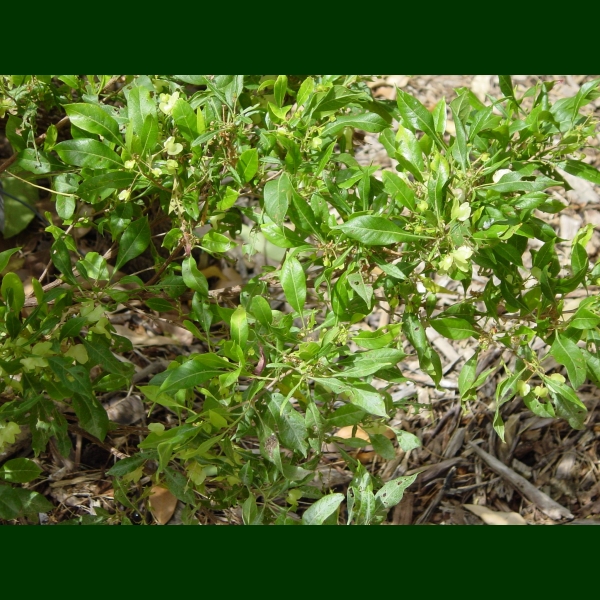 Hawaiian Name(s): ‘a‘ali‘i, ‘a‘ali‘i kū makani, ‘a‘ali‘i kū ma kua, kumakani
Hawaiian Name(s): ‘a‘ali‘i, ‘a‘ali‘i kū makani, ‘a‘ali‘i kū ma kua, kumakaniScientific Name: Dodonaea viscosa
Vernacular Name: none
Family: Sapindaceae
Status: indigenous
Authority: Jacq.
Description: Shrub/tree.
Habitat Found on open sites, ridges, lava, low pastures, shrublands, dry to mesic and wet forest, and subalpine shrubland, 3–2347 m on all main islands except Kaho‘olawe (Wagner et al. 1990:1227–1228).
Medicines: In a treatment termed holoina, ‘a‘ali‘i leaves are mixed with ala‘a bark (Pouteria sandwicensis) and puakala ku kula root (Argemone glauca) then ground and strained. The liquid is heated in a steam bath, which is followed with a purge of ground pilikai fruit (Stictocardia tiliifolia) to treat skin rash (‘ohune or mane‘o) (Chun 1994:2–4).
Non Medicinal Uses: Wood is hard, heavy, durable; sometimes used for houseposts and spears; many uses for fruits, such as a medicine, dye, and in lei, flowers also used in lei (Abbott 1992:68; Krauss 1993:65; Little & Skolmen 1989:180; Malo 1951:21). Pioneer species (Lamb 1981:78); made into "bait sticks", these were shaped and then charred in the fire (Krauss 1993:45). In the Ethnology Collection at Bishop Museum there is a post-contact example of the wood made into a bowl.
Specific gravity of wood: unknown
Famous Locations:
Mele: "Hoa pili o ke ‘a‘ali‘i." line in "Sweet Lei Mamo" (Elbert & Mahoe 1970:92).
`Ōlelo Noeau: [I] He ‘a‘ali‘i ku makani mai au; ‘a‘ohe makani nana e kula‘i. I am a wind-resting ‘a‘ali‘i; no gale can push me over. A boast meaning "I can hold my own even in the face of difficulities." The ‘a‘ali‘i bush can stand the worst of gales, twisting and bending but seldom breaking off or falling over. [II] He hina na ka ‘a‘ali‘i kumakani, he ‘ula‘a pu me ka lepo. When the wind-resting ‘a‘ali‘i falls, it lifts the sod up with its roots. A boast: When I, a powerful man, fall, others will fall with me. [III] He iki ‘a‘ali‘i ku makani o Pi‘iholo. A small, wind-resting ‘a‘ali‘i bush of Pi‘iholo. A small but powerful person.
Dye Color and Parts: Red (capsules)
Kino lau:
Location on Bishop Museum Kalihi Campus:
Propagation Information: Easy. Presoaked seeds sprout in 2-4 weeks, when 2 sets of leaves appear transplant into individual pots; broad elevation range but must drain well; will grow well in a large pot on apartment lanai (Bornhorst 1996:37–8; Bornhorst and Rauch 1994:10; Culliney and Koebele 1999:35–37; Nagata 1992:1993 addendum).
Hawaiian Native Plant Propagation Database.
Native Plants Hawaii.
Seed: Seed length approximately 2.2 mm. Photograph: B.Kennedy

Microscopy
Cross Section: Field of view: 2.6 mm x 1.6 mm. Photograph: H.Lennstrom

Radial Section: Field of view: 2.6 mm x 1.6 mm. Photograph: H.Lennstrom

Tangential Section: Field of view: 2.6 mm x 1.6 mm. Photograph: H.Lennstrom

